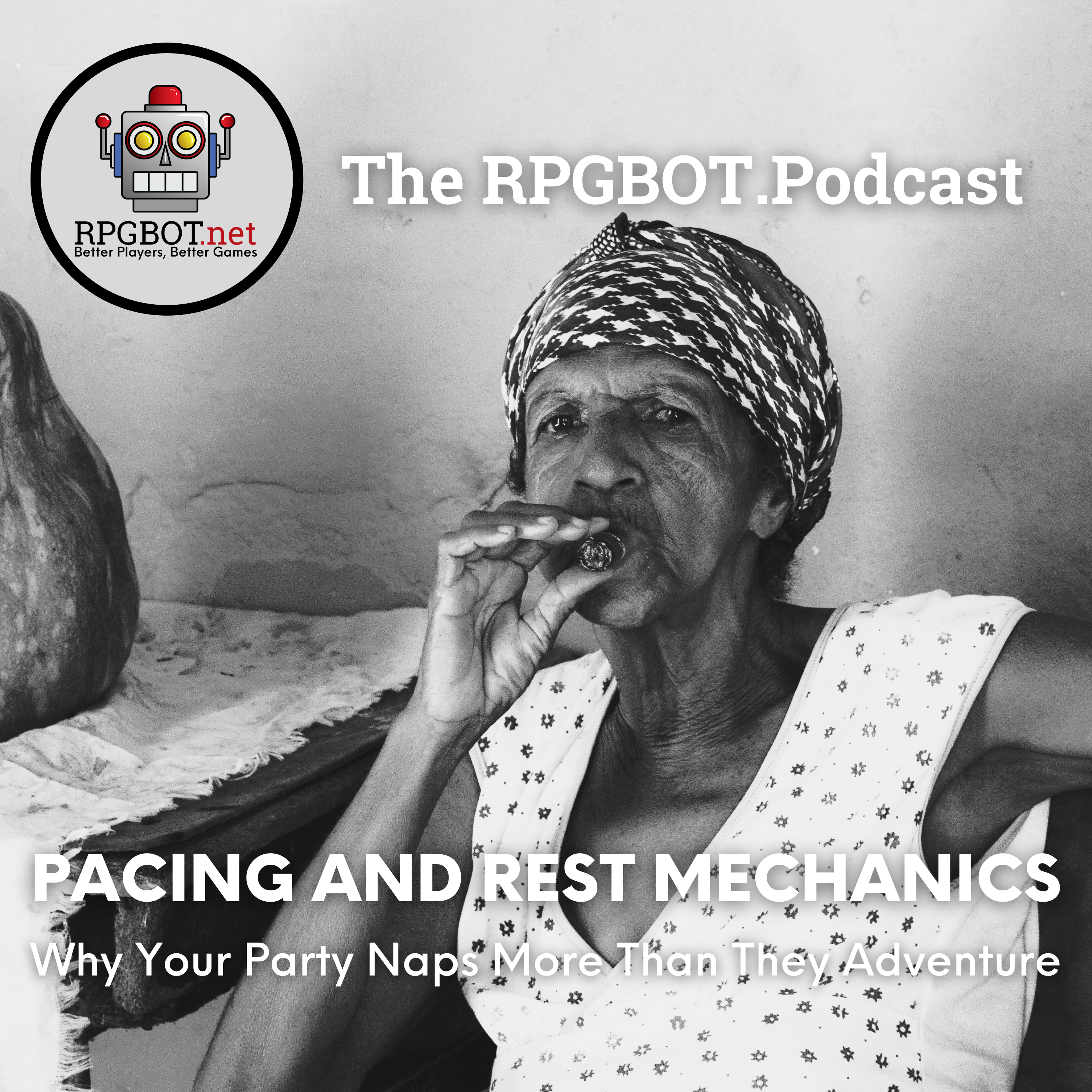View Transcript
Episode Description
Have you ever noticed that in real life, you can’t just say, “I take a long rest” and wake up eight hours later fully healed, your fridge restocked, and your inbox cleared? If only. Instead, you wake up groggy, your cat’s screaming, and somehow your wizard spell slots are still gone.
Well, tabletop RPGs aren’t much better. Pacing and rest mechanics are the part of D&D, Pathfinder, and other RPGs where your party argues for 30 minutes about whether to camp in the murder dungeon, or limp back to town because someone stubbed their toe. And let’s be honest—no one wants to play the “Five Minute Adventuring Day” where your heroes spend more time napping than actually adventuring.
In this episode, we’re tackling the eternal question: how do you keep the action exciting without turning your campaign into a sleep study?
Listen to RPGBOT.Podcast on YouTubeBefore we dive in—did you know the RPGBOT.Podcast has a massive archive of episodes now available on YouTube? Whether you missed our deep dives on D&D subclasses, Pathfinder tactics, Stormlight Archive RPGs, or Spooktober monstrosities, or you just want to binge the chaos from the beginning, the archive’s got you covered.
Hit up YouTube.com/@RPGBOT and subscribe so you never miss an old favorite—or a new disaster.
Show NotesEvery Dungeon Master, Game Master, and table of players eventually wrestles with one of the most elusive beasts in tabletop RPGs: pacing. How do you keep the story moving, the tension high, and the action balanced—while still letting your players rest their weary hit points and spell slots? In this remastered episode of the RPGBOT.Podcast, Tyler, Randall, and Ash dive into pacing and rest mechanics in tabletop RPGs, exploring how rules like short rests and long rests in Dungeons & Dragons, or Encounter Mode vs Exploration Mode in Pathfinder 2e, shape the tempo of campaigns.
We’ll dig into the ways pacing affects encounter design, narrative arcs, and character development, and how rest mechanics in Pathfinder and D&D can make or break the flow of the game. From gritty survival pacing where every rest is a gamble, to fast-paced cinematic RPG storytelling where players hardly stop to breathe, we cover strategies for keeping your table engaged without letting fatigue—or rules confusion—drag the campaign to a crawl.
If you’ve ever asked yourself:
- “How many encounters should happen before a long rest in D&D?”
- “How do I keep players from spamming the five-minute adventuring day?”
- “What’s the balance between story pacing and resource management?”
…this episode has you covered. Whether you’re a seasoned DM running epic campaigns in D&D 5e, a Pathfinder 2e GM wrangling Encounter Mode pacing, or just curious how to keep your RPG sessions balanced and fun, this discussion will give you tools, laughs, and maybe a little existential dread about resting in real life.
Key Takeaways- Pacing is everything: The tempo of encounters, story beats, and rests directly impacts campaign flow.
- Rest mechanics shape tension: Rules like short vs long rests in D&D or daily recovery in Pathfinder 2e can either encourage resource management or invite “rest spamming.”
- Encounter pacing drives drama: How many encounters players face before resting sets the stakes—whether it feels like a survival grind or a cinematic sprint.
- Balance mechanics with story: Great pacing blends mechanical tension (hit points, spell slots, conditions) with narrative urgency (villains, clocks, or looming disasters).
- The 5-minute adventuring day problem is real: Creative pacing strategies help DMs push beyond it.
- Different RPG systems, different solutions: What works for D&D pacing may not work for Pathfinder rest mechanics or other TTRPGs—adapt to your system.
- Player expectations matter: Some groups love slow-burn exploration, others want fast action. Pacing tools let you tune the campaign to your table.
Tabletop RPGs don’t just fall out of the sky like loot drops—they’re created by real human beings who need to pay rent, eat food, and occasionally buy dice they don’t actually need. If you love D&D, Pathfinder, or any of the countless indie RPGs out there, do the right thing: support the developers who make them.
Buy the books. Back the Kickstarters. Leave glowing reviews. Tell your friends about the cool stuff you’ve found. And yes—buy your GM a sandwich once in a while. Because without these hardworking designers and storytellers, we’d all still be pretending that Monopoly is a roleplaying game.
Welcome to the RPGBOT Podcast. If you love Dungeons & Dragons, Pathfinder, and tabletop RPGs, this is the podcast for you.
Support the show for free: Rate and review us on Apple Podcasts, Spotify, or any podcast app. It helps new listeners find the best RPG podcast for D&D and Pathfinder players.
Level up your experience: Join us on Patreon to unlock ad-free access to RPGBOT.net and the RPGBOT Podcast, chat with us and the community on the RPGBOT Discord, and jump into live-streamed RPG podcast recordings.
Support while you shop: Use our Amazon affiliate link at https://amzn.to/3NwElxQ and help us keep building tools and guides for the RPG community.
Meet the Hosts
-
Tyler Kamstra – Master of mechanics, seeing the Pathfinder action economy like Neo in the Matrix.
-
Randall James – Lore buff and technologist, always ready to debate which Lord of the Rings edition reigns supreme.
-
Ash Ely – Resident cynic, chaos agent, and AI’s worst nightmare, bringing pure table-flipping RPG podcast energy.
Join the RPGBOT team where fantasy roleplaying meets real strategy, sarcasm, and community chaos.
How to Find Us:
In-depth articles, guides, handbooks, reviews, news on Tabletop Role Playing at RPGBOT.net
Tyler Kamstra Ash Ely Randall James Producer Dan